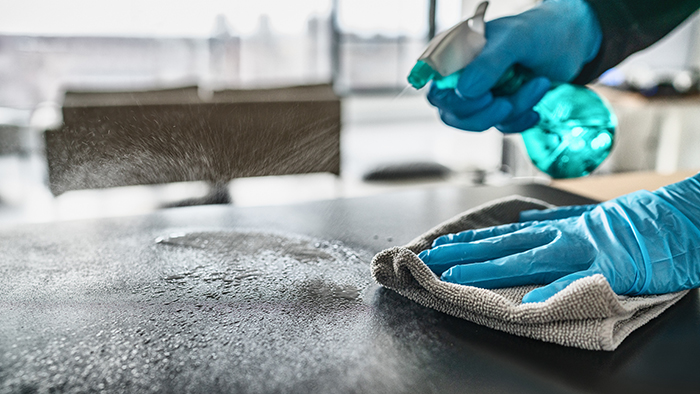
COVID-19
What We Have Learned From the Pandemic, Part 8
By Michael Meyer, Writer/Editor; and Madilyn Moeller, Editorial Assistant, American Med Spa AssociationEighteen months ago, COVID-19 emerged and changed the ...
Posted By Mike Meyer, Friday, August 14, 2020

By Christie Hutchinson, CEO, QCC Healthcare Consultants
Occupational Safety and Health Administration (OSHA) compliance and disinfection protocols are hot topics in the medical spa world right now. Many medical spa owners and operators are asking questions related to OSHA regulations and re-opening. For starters, you should know that OSHA's primary purpose is to maintain employee safety. For medical spas specifically, it is mostly centered around laser safety, personal protective equipment (PPE), bloodborne pathogens and general safety. Following are 10 practical tips for staying—or, for some of you, becoming—compliant with OSHA, given the new COVID-19 environment.
These change often, and you are responsible for staying abreast of the current requirements. Even the U.S. Centers for Disease Control and Prevention's (CDC's) guidance is evolving as more is learned about COVID-19. Bookmark these agencies' sites on your web browser so that you can refer to them as needed. For county and city agencies, try searching "name of city/county + coronavirus + guidelines"; for state agencies, try searching "name of state + department of health." Your legal advisor is also a huge asset in this area. Don't rely on gossip and rumors.
It is critical that all levels of staff and your medical director are involved with discussions about safety, quality and re-opening. Listen to their concerns and share the information that you have with them. Consider every person's perspective as decisions are made for the medical spa. When an employee feels heard, they are more likely to be on board with the forward progress and less likely to take their concerns to a third party.
Having these things documented will allow you to effectively communicate with everyone involved. If necessary, update your current policies and/or create new ones. It is imperative that the team presents a united front and is confident in their actions to provide for the safety of their coworkers and patients.
If your team collectively decides that staff members are always required to wear a mask, then it is important that everyone is held to that same standard. Quickly address substandard behavior and unsatisfactory compliance with the rules.
Make sure that the PPE is appropriate in size and is used for the correct circumstances. It is also important to note that the PPE needs to be available wherever one might need it—for example, your PPE should not be stored in a cabinet at the back of the facility. Leadership is also responsible for the inspection, maintenance and replacement of PPE. Damaged items should not be used. When educating employees on PPE use, include training on the limitations, care and maintenance of the supplied PPE.
It is the responsibility of the employer to ensure that staff members are educated on safety and infection prevention. Education includes providing access to the information, and ensuring understanding and retention of the information. Creating an educational module and then providing a post-module quiz to assess for understanding is a simple way to accomplish this. (You can see this with services such as 1st Healthcare Compliance, which you can visit here, and quizzes can be created by consultants you work with, as well.) Direct observation and competency checks also can provide for educational assessments.
In the event of an OSHA inspection, licensing board investigation or conflict with an employee, your documentation of education can protect you. Here are some ways to document education:
Each of these can be placed in an employee's human resources file for recordkeeping.
Laser safety, chemical hazards, proper handling of biohazardous waste, mitigation of needlesticks and infection control of all communicable diseases should continue to be top priorities for effective safety and infection prevention in medical spas. If you are not already compliant and knowledgeable in these areas, now is the time to correct this. Know that once a regulatory organization enters your facility, all infractions are fair game.
Here is a review of a few key items regarding disinfection.
In fact, employers can be fined for not providing appropriate PPE—right size, suitable equipment, proper availability—and for not enforcing the correct use of PPE. Your policies should outline the procedures that require PPE use, exactly what PPE items are required and what items are recommended. Include when to wear a mask versus a face shield and when to wear eye protection. Remind your staff to perform hand hygiene before and after glove use.
Most importantly, maintain your patience, educate and communicate with your team, and know your regulations and guidelines. Above all, stay committed to safe and high-quality care.
For legal updates and business best practices delivered straight to your inbox, subscribe to AmSpa's email newsletter. For more information on how AmSpa can help your practice operate legally and profitably, contact us online or call us at 312-981-0993.
Christie Hutchinson is the CEO of QCC Healthcare Consultants, where she works with health care organizations to improve their compliance, quality and operational efficiencies. As a health care risk manager, she is instrumental in identifying successes and areas of opportunities for her clients, assisting them in achieving the highest level of quality care for their patients. Her professional background includes ER nurse, COO for a pediatric urgent care system, and vice president of care coordination for a publicly traded health care organization. Hutchinson can be contacted at 214.226.1282 or christie@qcchealthcare.com, or visit the QCC Healthcare Consultants website.
Related Tags
Medical spa news, blogs and updates sent directly to your inbox.

COVID-19
By Michael Meyer, Writer/Editor; and Madilyn Moeller, Editorial Assistant, American Med Spa AssociationEighteen months ago, COVID-19 emerged and changed the ...

COVID-19
By Michael Meyer, Writer/Editor; and Madilyn Moeller, Editorial Assistant, American Med Spa AssociationEighteen months ago, COVID-19 emerged and changed the ...

COVID-19
By Michael Meyer, Writer/Editor; and Madilyn Moeller, Editorial Assistant, American Med Spa Association Eighteen months ago, COVID-19 emerged and ...

COVID-19
By Michael Meyer, Writer/Editor; and Madilyn Moeller, Editorial Assistant, American Med Spa AssociationEighteen months ago, COVID-19 emerged and changed the ...